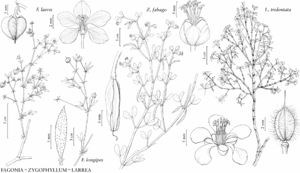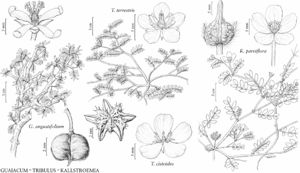Difference between revisions of "Zygophyllaceae"
FNA>Volume Importer |
imported>Volume Importer |
||
| (4 intermediate revisions by 2 users not shown) | |||
| Line 95: | Line 95: | ||
|basionyms= | |basionyms= | ||
|family=Zygophyllaceae | |family=Zygophyllaceae | ||
| + | |illustrator=Barbara Alongi | ||
| + | |illustration copyright=Flora of North America Association | ||
|distribution=North America;Mexico;West Indies;Central America;South America;Eurasia;Africa;Atlantic Islands;Indian Ocean Islands;Pacific Islands;Australia;mostly tropical or subtropical regions;mainly in arid and semiarid areas. | |distribution=North America;Mexico;West Indies;Central America;South America;Eurasia;Africa;Atlantic Islands;Indian Ocean Islands;Pacific Islands;Australia;mostly tropical or subtropical regions;mainly in arid and semiarid areas. | ||
|reference=beier2004a;porter1972a;porter1974a;sheahan1996a;sheahan2000a | |reference=beier2004a;porter1972a;porter1974a;sheahan1996a;sheahan2000a | ||
| Line 100: | Line 102: | ||
|publication year= | |publication year= | ||
|special status= | |special status= | ||
| − | |source xml=https:// | + | |source xml=https://bitbucket.org/aafc-mbb/fna-data-curation/src/2e0870ddd59836b60bcf96646a41e87ea5a5943a/coarse_grained_fna_xml/V12/V12_121.xml |
}}<!-- | }}<!-- | ||
-->[[Category:Treatment]] | -->[[Category:Treatment]] | ||
Latest revision as of 19:13, 5 November 2020
Herbs, subshrubs, shrubs, or trees, annual or perennial, branching usually divaricate, growth sympodial, nodes angled or swollen, evergreen [deciduous], synoecious [dioecious]. Leaves opposite or fascicled [alternate or on short lateral branches], palmately or even- [odd-]pinnately compound [simple]; stipules present; petiole present [absent]; blade often fleshy or coriaceous, margins entire; venation pinnate. Inflorescences pseudoaxillary [terminal], flowers solitary or in 2-flowered clusters [cymes]. Flowers bisexual [unisexual], usually regular, sometimes slightly irregular; perianth and androecium hypogynous; hypanthium absent; sepals 4–5, usually distinct, rarely connate basally; petals 4–5, distinct [rarely connate basally], often clawed, sometimes twisted; nectary usually present, extrastaminal and/or intrastaminal, rarely absent; stamens [5–](8–)10 in 2 whorls, outer usually opposite petals, often alternately unequal in length or sterile, distinct, free or adnate to petal bases, inserted on or proximal to nectary, frequently glandular or appendaged at base; anthers dehiscing by longitudinal slits; pistil 1, (2–)5-carpellate, ovary superior, (2–)5–10-locular; placentation axile [basal]; ovules (1–)2–10 per locule, anatropous; style 1; stigma 1. Fruits capsules, dehiscence septicidal or loculicidal, or schizocarps splitting into 5 or 10 mericarps. Seeds 1–5(–10) per locule.
Distribution
North America, Mexico, West Indies, Central America, South America, Eurasia, Africa, Atlantic Islands, Indian Ocean Islands, Pacific Islands, Australia, mostly tropical or subtropical regions, mainly in arid and semiarid areas.
Discussion
Genera 27, species ca. 240 (6 genera, 15 species in the flora).
Zygophyllaceae are most closely related to Krameriaceae and the two families make up the isolated order Zygophyllales (Angiosperm Phylogeny Group 2003). A number grow in saline soils. Three species are cultivated in milder winter areas of the southeastern United States for their colorful flowers: the South American Bulnesia arborea (Jacquin) Engler and B. sarmientoi Lorentz ex Grisebach, both verawood, and the Caribbean Guaiacum officinale Linnaeus, lignum vitae. Guaiacum coulteri A. Gray, guayacán, from western Mexico and Guatemala, is grown in southern Arizona. Peganum, often placed in the Zygophyllaceae, is now recognized to be a member of the unrelated Nitrariaceae (Angiosperm Phylogeny Group).
Selected References
Lower Taxa
Illustrations
Key
| 1 | Leaflets 2. | > 2 |
| 2 | Leaflets distinct. | Zygophyllum |
| 2 | Leaflets connate basally, leaves appearing simple and 2-lobed. | Larrea |
| 1 | Leaflets (1–)3 or (4–)6–16(–20). | > 3 |
| 3 | Leaves palmately compound; leaflets (1–)3, apex spinose or spinulose. | Fagonia |
| 3 | Leaves pinnately compound; leaflets (4–)6–16(–20), apex not spinose. | > 4 |
| 4 | Trees or shrubs; petals usually blue to purple, rarely white; fruits capsules, 2–5-lobed. | Guaiacum |
| 4 | Herbs; petals white or yellow to bright orange, bases sometimes green or red; fruits schizocarps, 5-angled or 10-lobed. | > 5 |
| 5 | Ovaries 5-lobed, 5-locular; fruits 5-angled, spiny, breaking into 5 mericarps (rarely fewer); petals yellow, base darker; nectary 10 glands in 2 whorls. | Tribulus |
| 5 | Ovaries 10-lobed, 10-locular; fruits 10-lobed, not spiny, breaking into 10 mericarps (sometimes fewer); petals white to bright orange, base white to bright orange or green to red; nectary 5 glands at bases of filaments opposite petals. | Kallstroemia |

